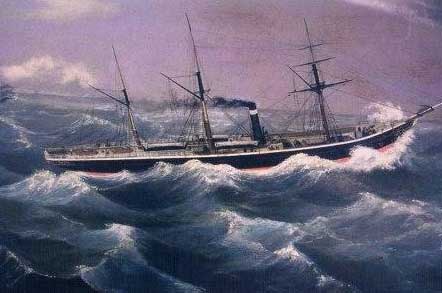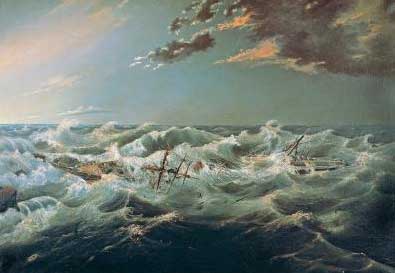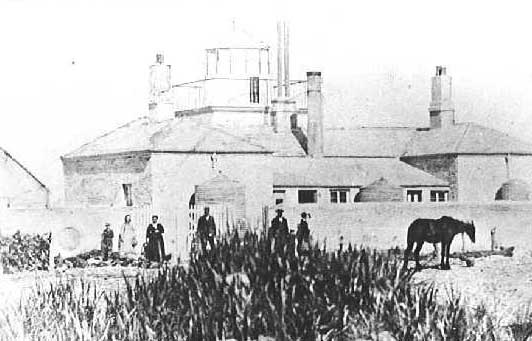Introduction.
SS Admella was an iron hulled, three masted steam ship of 209 tons, that also carried sails. Built in Glasgow in 1857, she was 55.6 metres long, named after the route she followed, Adelaide, Melbourne and Launceston, taking the letter Ad, Mel and La to combine to form her name. She carried sails on the 3 masts.

SS Admella with her three masts, and funnel in view
Last Sailing.
This vessel sailed from Port Adelaide at 1730 ( 5. 30 P M ) for Melbourne, on Friday August 5, 1859. She was commanded by Captain Hugh McEwen, her crew and passengers numbered 113.
Cargo.
She was loaded with 93 tons of copper, flour for the Victorian Goldfields, general merchandice and 7 horses including 4 racehorses. If one thinks about it, sea transport was really the only way to transfer horses between States, other than the horses walking the total distance to be covered.
Rough weather.
About 1300 ( 1 PM ) when the ship was level with the Cape Willoughby light, and heavy seas caused the racehorse Jupiter to fall on its back in his box.

The Cape Willoughby Lighthouse on Kangaroo Island
Cape Willoughby was the first lighthouse to be erected in South Australia, and lights the Backstairs Passage between Kangaroo Island and the mainland.
To assist in righting this horse, Captain Mc Ewen turned the ship's bows into the swell, and reduced speed, After about an hour Admella returned to her normal course, parallel with the shore.
Some 75 miles had been covered by midnight in rather foggy conditions.
Just after 0500 ( 5 A M ) the ship shuddered, striking a sunken reef, the heavy seas running at the time threw the ship another 20/30 feet further onto the rocks, and she listed heavily so that the starboard side was high and dry out of the water.
The ship's boats were ordered to be swung out, but Admella broke into three pieces within 15 minutes of grounding. She was stranded, the only means of summoning help was for someone to swim ashore and raise the alarm.

Admella wreck
The Second Mate put up his hand to take on this onerous task, but soon disappeared to be lost in the raging waters.
A raft was built and launched, after a three hour struggle it made the shore, and survivors walked some 15 miles to the Cape Northumberland light which is close to the South Australia/Victorian border.

The old MacDonnell Lighthouse, circa 1870
Photograph courtesy: Port MacDonnell & District Maritime Museum.
History
The original MacDonnell Lighthouse was built in 1858 and commenced operation in early 1859. The original light had three faces - white, red and green - which it exhibited in succession.
The site was narrow and quite exposed with the buildings being built too close to the cliff edge. Therefore, this light survived only 23 years, due to the danger of its collapse from the cliff on which it stood being undermined by wind and sea. After the new Cape Northumberland Lighthouse was built in 1882 on a hill 400 metres to the east, the MacDonnell Lighthouse was demolished.
Here the head keeper B.Germein was informed and he took off on horseback for the Post Office at Mount Gambier, but fell off en route, and John Black a station owner took his place to alert authorities of the disaster and the plight of any survivors.
Portland, some 200 miles away had the nearest lifeboat available, now Germein organised a small boat to be transported by dray to the wreck site.
On the 11th. of August he attempted to launch the boat but failed as it was soon swamped by the high seas.
The Corio arrives.
Captain Quinn in the Corio arrived on the scene, and launched the Pilot Boat she carried onboard, after battling the wild weather for an hour its 7 crew were forced to land on the beach.
Back aboard Admella, the 50 survivors built another raft in an attempt to leave the wreck, only to see it drift off into the distance.
Now Corio running short on coal was forced to depart for Robe, nothing was going right and the survivors must have been close to despair.
SS Lady Bird arrives at the wreck site.
SS Lady Bird towing the Portland lifeboat and a whaler appeared on the scene.
SS Ant ex Robe now also turned up to assist in any rescue operations.
Friday the 11th. of August.
It was now one week on since Admella had sailed from Port Adelaide, as the life boat came close to the wreck site, but all attempts at getting a line across and secured to the wreck failed, and it returned to the LadyBird.
Now in calmer conditions on the following day, both Germein in his small boat and the lifeboat returned to Admella, and at long last a line was secured.
Captain McEwen, Thomas Davey and Andrew Fuller all managed to board Germein's boat, and they were transferred to the Pilot Boat and successfully taken ashore.
The Portland lifeboat came alongside Admella, a line fastened to the wreck and 18 men and one woman were finally rescued.
But out of the original complement of 113 on board, but 24 who sailed had survived, 13 crew members and 11 passengers.
Commission of Inquiry as to the loss.
A Commission appointed to decide on the loss of SS Admella, found the principal cause was a strong inshore current, her Captain was cleared of any blame but criticised for not taking soundings when unsure of his true position.
Salvage.
In August 1859 an auction was held to dispose of goods salvaged or washed ashore, it realised 850 Pounds.
In 1860 the wreck was sold to R. Anderson of Mount Gambier and H. Chant, who recovered more material from the wreck site.
Anderson used some recovered materials to construct a cottage at Port MacDonnell.
In 1957, almost a hundred years later, skin divers did salvage some of the copper in the ship's hold, and they formed a syndicate to recover more of this precious metal, iron plates ex Admella, were used to reinforce crumbling walls at the Robe prison.
A small signal cannon was recovered and restored and is displayed at the Maritime Museum at Port MacDonnell.

Signal cannon ex Admella
A cairn at Cape Banks commemmorates the wreck, and at Cape Northumberland close to the early light house site is a memorial recalling the deeds of the Head Light keeper B. Germein, who played a big role in the rescue bid.
The lifeboat used in rescue operations is still on display at Portland.
Finally, the Maritime Museum at Port Adelaide carries a small collection of Admella relics.

Australian Stamp Issue to remember three shipwrecks. Issued on May 1, 2007.
Admella Lock Ard Dunbar
50 cent stamp. $1 stamp. $2 stamp.
List of Armella Passengers and Crew and those who survived.
Passengers and Crew of the Ship Admella
Twentyfour individuals - 11 passengers and 13 crew members survived.
Crew that survived
- Hugh McEwan, master
- James Hutcheson, first mate age 33
- GB McNair, purser
- George Hills, fore cabin steward age 23
- George Ward, cabin boy
- John McDermott, second cook
- David Peters, fireman age 24
- Robert Wright, trimmer
- Robinson Duchering, lamp trimmer age 23
- Charles Locke, able seaman
- John Welch, able seaman
- Robert Knapman, able seaman
- John Leach, able seaman
Passengers that survived
Cabin
- Hurtle Fisher, Adelaide
- Miss Bridget Ledwith, Adelaide
- James Miller, Victoria
- Benjamin Rochfort, Adelaide
Fore-cabin
- Patrick Carrick
- Thomas Davey
- Michael Forrester
- Patrick Glynn
- Hugh McInnes
- Thomas O'Halloran
- Thomas Richardson
- James Webb
- Andrew, servant to Mr Rochfort
Eighty-one* people perished - 66 passengers and 15 crew.
* This figure varies between reports from 81 to 89 but at this stage we have only 81 names. The 150 anniversary celebrations web site claim 89 died.
Crew that perished
- 1. Walter Brown, second engineer age 24
- 2. Miss Clendinning, stewardess
- 3. James Hare / Hur, cabin steward age 33
- 4. Soren Holm, able seaman
- 5. John Johnson, second mate
- 6. Margaret Meagher, fore cabin stewardess
- 7. Simon Munro, first engineer age 33
- 8. J Orr, first cook
- 9. Unnamed aassistant steward
- 10. Unnamed aassistant steward
- 11. A seaman
- 12. A seaman
- 13. A seaman
- 14. A fireman
- 15. A fireman
Passengers that perished
Cabin
-
1. George Fisher, Adelaide
- 2. Mrs Glynn
- 3. Cpt Harris, master mariner, Adelaide
- 4. Henry Holbrook, Adelaide (Death certifcate issued in Adelaide)
- 5. James Magarey, Geelong
- 6. Miss Nugent, Adelaide
- 7. Dr Vaux, Ship Norfolk
- 8. James Whittaker, ex-convict and proprietor of Sir John Franklin Hotel, Kapunda
Fore-cabin
- 9. Patrick Arthur
- 10. Fernando Bade
- 11. Benjamin Baker
- 12. John Battrick
- 13. Mrs Catherine Beith nee Weir age 31
- 14. Catherine Beith age 10
- 15. Jane Beith b. 1857 Norwood SA
- 16. John Beith b. 1855 Norwood SA
- 17. Robert Beith age 8
- 18. Mrs Madeline Bowie nee Beith age 39 w/o James
- 19. John Carmichael, unm
- 20. Edwin Chambers
- 21. Mrs Coxell
- 22. child Coxell
- 23. James Davidson
- 24. John Davis
- 25. George Forrester
- 26. Mrs Forrester
- 27. Wilhelm Alfred French.
- 28. Mrs Gold
- 29. Mrs Goode
- 30.Henry Grosse
- 31. Edward Haynes
- 32. Wilhelm Hermann
- 33. Edwin Jackson
- 34. Mrs Kerwin
- 35. Kerwin child
- 36. Kerwin child
- 37. Kerwin child
- 38. Richard King
- 39. Patrick Lennan
- 40. Mrs Lennan
- 41. Thomas R Mensforth
- 42. Mr Murray
- 43. Mrs Murray
- 44. John O'Brien, age 19
- 45. Eliza Paul
- 46. Mrs Ramsay
- 47. William Rosewell
- 48. Wilhelm Schultz
- 49. Charlotte Short
- 50. Charlotte Short b. 1857
- 51. Henry J Short b. 1854
- 52. John Short, child
- 53. Thomas Short b. 1856
- 54. William Taylor
- 55. John Tregeagle
- 56. Walter Underwood, a youth
- 57. George Watkins
- 58. Hester Watkins
- 59. John Watson
- 60. Mrs Watson
- 61. Watson child
- 62. Watson child
- 63. Mrs Weatherall
- 64. Allan Sebastian Webb (Death certifcate issued in Adelaide)
- 65. Mr Williamson
- 66. Mr Wood
The Biographical Index of South Australians lists an Aldborough R Davies whose name was not on any lists.
I am beholden to this URL: http://www.jaunay.com/admella.html for facts relating to this disaster back in 1859.
Conclusion.
The wreck of SS Admella still remains the greatest loss of life at sea in the history of European settlement in South Australia. The sea is a hard taskmaster, and some 7,303 shipwrecks lay on the ocean floor of the Australian coastline, many of them around both South Australia and Victoria.
It is the Scuba Diving fraternity that often locates and reports the position of wrecks that litter our coastline, thus adding to our rich Maritime Heritage.
So, a big thank you is due to all intrepid Divers who assist in this way.






